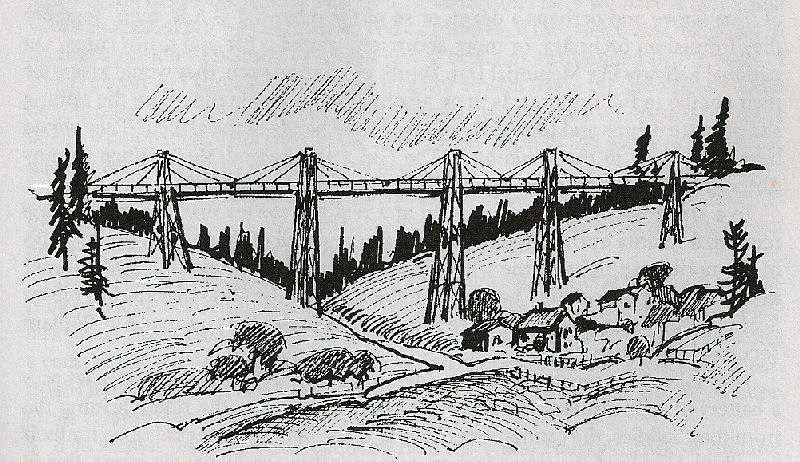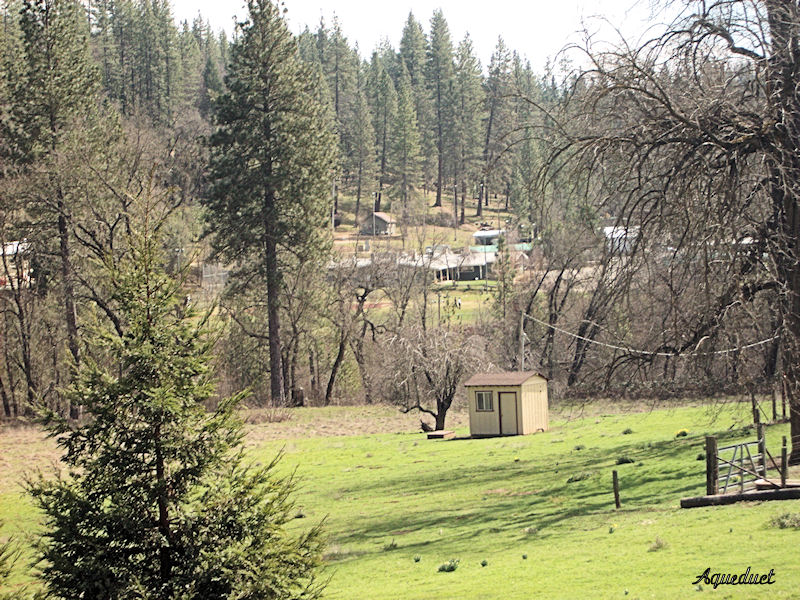





|
|
Aqueduct City, Amador County Ghost Town | ||
|
Surprised Logan was, Reader, to discover that none of his previous writings ever considered Aqueduct and Grass Valley, at whose head the village once stood. Don't call it a ghost city, however. That would vex the one business and also the Louis F. Ludekens, dwelling rests in the suburbs. That family has made the valley home since the 1850's, but their annals will have to be subject another time. Now the subject will be the Grass valley "ranche," Plattsburg, and, finally, Aqueduct. |
|
|
|
Where is this almost bypassed place in Amador's history? The Pine Grove conservation camp occupies much of the valley, or at least its north and west half, once sat at the sharp bend in highway 88 beyond its junction with the Volcano-Aqueduct road. Not all men who adventured into these hills sought gold. Some were seekers of land to ranch or farm, and small mountain meadows and dales, with their lush sprng grasses, were much in demand. The valley acquired its name of "Grass" in 1850 or before. First to claim all or part were John Pero and Joseph Moran, who claimed 640 acres "for farming" in 1850, their claim beginning in the northwest corner of Grass Valley. |
||
|
The following January F.B. Taylor and others had valley "near the Volcano" surveyed by Calaveras county surveyor John Reid, limiting their claim to 160 acres. Later that year Beriah and John Botkin, John Stahl and James C. Woods claimed a site near that northwest end of the valley for a quartz mill. Also at that end of the valley, near the road to Volcano, would arise the sawmill of A.P. Clough and company in 1854. |
|
|
In October, 1852, Albert and Henry Land and Taylor sold 320 acres of the valley to Thompson and John Perrin. That spring diarist John Doble described the valley, after one of his shanksmare peregrinations, as "a beautiful flat about a mile and a half long by 200 to 300 yards wide... Doble observed that it was all fenced and that the owners had a store. That may have been Land's and Taylor's store, but our historian Jesse D. Mason says the first store was Graham's and Biggs'. Maybe the former was located along the present Volcano-Pine Grove road, and the latter was the first where the village would be. Doble, sensitive to nature's allure, rhapsodized about the valley's "beautiful verdure and varicolored flowers and grasses" that spring. The ranchers offered him $3 a day to mow their grass and barley, but Doble declined. He could get twice that in Volcano laboring. Historian Mason says that placer diggings were discovered at the head of the valley as early as 1850, maybe where French gulch empties into the valley's brook about where the village would sprout. You can read about a report from those diggings in 1853 in the Sacramento Union. But those placers didn't amount to much or a village would have been established there. By 1854 the placers probably weren't any better, but another cause would be mid-wife to the village's real birth. That was the great ditch or canal works of the Jackson water company, destined to emerge from the Mokelumne river canyon and cross the ridge near the place on its way to Volcano. To convey the water from the ridge across the gulch to another ridge, a great flume or aqueduct would have to be erected. Thus, if the diggings themselves didn't do it, the promise of the canal and ample water to work those diggings could. As the canal came down the canyon, the village began to grow. One of the principals in this great canal venture was an Illinoisian, Alonzo Platt, a lawyer by profession, and an investor in quartz mills in Sutter Creek and sundry enterprises ambient. Maybe the camp was already called Grass Valley City in 1854 before it was naaied Plattsburgh, after Platt. Said the San Joaquin Republican in May (quoting the Jackson Sentinel): "(The) camp ... (is) where the Jackson Water Company's flume is to cross the divide ridge. A large number of miners are already there." Its name? Plattsburgh. No doubt Mr. Pratt at the nearby Grass Valley sawmill was envious. Would not naming Plattsburgh "Prattsburgh" be just as apt? Apparently, like Pratt's supposed envy, the name of Plattsburgh was short-lived. It probably was Grass Valley City again until the fall of 1854 when the canal came! The name it would acquire then still serves. IVAs the vaunted canal of the Jackson water company inched down the Mokelumne river canyon, the clapboard or two that was Plattsburgh or Grass Valley City attracted company. Incidentally, that great ditch's intake works were upstream from where the Bear met the larger Mokelumne, thus enabling the water company to tap both. Newspaper items gleaned from the Jackson Sentinel by the Sacramento Union tell us what the growing hamlet was like in 1854. Maybe "hamlet" is used prematurely, for the place's most well-known citizen; captain An Ham, didn't arrive until 1855. Sometime circa November that year, townsmen opted for Aqueduct City as a more suitable name for the village which would be the site of the largest aqueduct in the whole canal system. It also could be that the water company had either. moved an office there or expressed intention of doing | ||

| ||
|
Information, photographs courtesy of the Amador County Archives, The Historical Marker Database, The Chronicling America Database, and Larry Cenotto, Amador County's Historian CONTACT US
|
||

